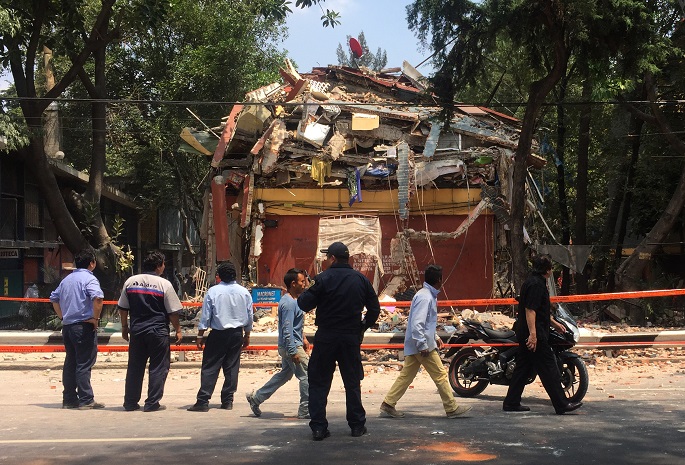216 killed in Mexico quake
Published : 19 Sep 2017, 22:43
Updated : 20 Sep 2017, 10:46
At least 216 people have been killed after a powerful earthquake hit central Mexico on Tuesday, with the death toll expected to rise due to the scale of the temblor, the country's civil protection agency said.
The magnitude-7.1 quake toppled dozens of buildings, broke gas mains and sparked fires, sending thousands of people fleeing into the streets in panic.
Fatalities were reported in capital Mexico City, nearby Morelos and Puebla states, the State of Mexico, and the south-central state of Guerrero, according to the head of Mexico's national civil protection agency, Luis Felipe Puente.
In his latest update of the number of people killed as a result of the major quake, Puente said there were 86 confirmed deaths in the Mexico City, 71 in Morelos, 43 in Puebla, 12 in Edomex and three in Guerrero.
The toll is expected to climb as many people remain trapped in the rubble of collapsed buildings.
Dozens of buildings tumbled or were severely damaged in densely populated parts of Mexico City and nearby states. Mexico City Mayor Miguel Angel Mancera said buildings fell at more than 40 places in the capital alone.
According to the U.S. Geological Survey, the epicenter of the quake was located 5 km from Raboso, Puebla.
Its proximity to the capital and its shallowness, just 51 km below ground, made the quake as intense as its destructive 8.2-magnitude predecessor that hit southern Mexico on Sept. 7, reportedly the strongest quake to jolt the country in a century.
Television footage showed the normally placid canals of the city's Floating Gardens of Xochimilco, a popular tourist attraction, churning with waves and boats tossed about as if on the high seas.
At 11:00 a.m. (1600 GMT), a nationwide earthquake drill marking the anniversary of the temblor that killed thousands on Sept. 19, 1985 had sent office workers and residents spilling into the streets.
Barely two hours later, people were scrambling out of buildings once again as seismic waves violently swayed light fixtures, knocked down plaster and caused water in fish tanks and coffee makers to spill out.
Mexican President Enrique Pena Nieto was en route to the southern state of Oaxaca to supervise recovery efforts there in the wake of the Sept. 7 quake, but his plane turned around and returned to the capital when he learned buildings had collapsed.
"I will fly over CDMX (Mexico City) and hold a meeting" to coordinate emergency efforts, he posted on Twitter.
However, the plane was unable to land at Mexico City's airport, where operations were temporarily suspended as officials inspected airstrips and buildings for damage. Since then, the airport has resumed operation.
In a video statement issued late Tuesday, the president urged people to stay calm.
He said many will need help, but the initial focus has to be on finding survivors trapped in wrecked buildings.
"The priority at this moment is to keep rescuing people who are still trapped and to give medical attention to the injured," he said.
According to him, as of late Tuesday, 40 percent of Mexico City and 60 percent of Morelos had no electricity.
The president stressed that he had ordered all hospitals to open their doors to the injured.
Interior Minister Miguel Angel Osorio Chong said search efforts were slow because of the fragility of rubble, adding that rescuers were unable to use machines and were using their bare hands and shovels.
"It has to be done very carefully," he said. "Time is against us."
Mexico City's subway system suffered a 10-minute power outage that interrupted service for some 40 minutes. Commuters in stations were told to stand close to the walls and stay put until station officials were able to review the facilities.
Officials later announced the system was offering free service, possibly to keep cars off the streets to make way for emergency vehicles.
The quake also damaged some roads.
A segment of the highway linking Mexico City to the nearest beach, the Pacific coast resort of Acapulco, collapsed between the city of Cuernavaca, Morelos, and Chilpancingo, Guerrero, Mexico's federal police reported.
Rocks and debris knocked onto the Santa Barbara-Izucar de Matamoros Highway, narrowing it to a single lane.
Education Minister Aurelio Nuno Mayer announced the suspension of classes at all levels until further notice in all of the affected regions.
Mexico is one of the world's most quake-prone nations. It is also susceptible to other natural hazards such as hurricanes and floods.


